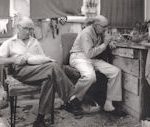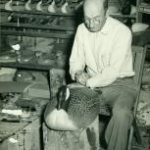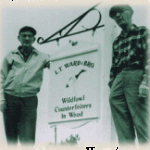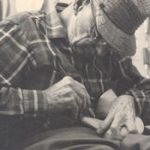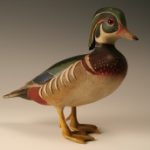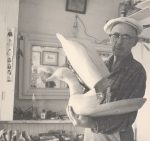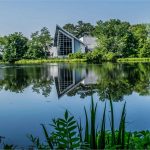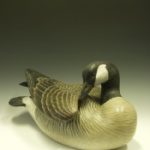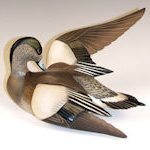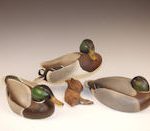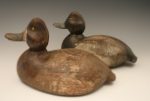Masters of Decoy and Decorative Bird Carving
For more than fifty years, the carving partnership of L. T. Ward & Bro. of Crisfield, Maryland created waterfowl decoys and decorative bird carvings that established and maintained a unique standard of realism and artistic expression. Stephen Ward (1895-1976) and Lemuel T. Ward, Jr. (1896-1984) were makers of hunting decoys until the early 1950s, when the introduction of plastic, factory-made hunting decoys and a growing collector demand for their realistic carvings prompted them to switch to the production of miniature and life-sized decorative birds.
Crisfield, on the eastern shore of the Chesapeake Bay, was literally created by the seafood industry. Located on a marshy peninsula, the town was built on a base of discarded oyster shells and prospered when the railroad and steamship lines became available to carry the town’s rich harvest of seafood to eastern cities.
Market hunting of waterfowl was not as widely practiced around Crisfield as it was in the upper Chesapeake Bay, and those Crisfielders who hunted for the market used methods that relied less on large spreads of decoys like the elaborate gunning rigs of the upper bay. Thus the typical round-bottomed upper bay decoy never became established in the Crisfield area.
With the outlawing of market hunting and the increasing numbers of sport hunters in the early 1900s, a distinctive style of decoy carving developed in the Crisfield area. These decoys were flat-bottomed, often oversized, with a nicely carved head that exaggerated the bird’s characteristics. The overall effect was a very lifelike decoy that was highly visible and rode the water like a duck, quite differently from the upper bay decoys that rolled and danced to the movement of the waves. One of the pioneer carvers of the Crisfield school was L. Travis Ward, Sr. (1865-1926), the father of Lem and Steve.
Both Ward brothers were barbers by trade, as was their father. Neither Lem nor Steve worked as a waterman or hunted commercially, but both were avid fishermen and hunters. Their close observation of wild birds is reflected in the realistic form and painting of their decoys. Other hunters of the time could not understand why the Wards would allow ducks and geese to alight among their decoys and swim around while they studied their shapes and color patterns.
Decoy making for the Ward brothers started about 1920 between customers in the old barbershop near Asbury Church, and gradually moved to their home workshop as their decoy business increased. The Depression years of the 1930s brought an increase in the demand for their decoys as more people hunted simply to feed their families. When better economic times returned, a growing interest in sport hunting, especially at the gunning clubs that flourished on the waterfowl-rich marshes and islands of the Bay, provided a demand for their decoys from hunters who could afford the best. Many clubs sent their decoys back to the Ward’s shop annually for repair and repainting.
Lem Ward was an innovator, always experimenting with new styles and paint patterns, perhaps to confound those who would copy his work, but mostly to satisfy his desire to create a more lifelike bird. Lem made a few decorative carvings as far back as 1918, but the change from making working decoys to consistently creating decorative pieces did not come until the 1950s. Steve Ward is often credited with doing most of the decoy carving and Lem with most of the painting, but this tends to oversimplify the close working relationship between the two brothers who formed a unique carving partnership.
Lem and Steve Ward had no training in art; their life in Crisfield isolated them from other artists. Neither of them owned an automobile, preferring to bicycle into town to shop and socialize. The inspiration for the carved and painted waterfowl that they created came from their keen observation of the birds that they knew so well in the surrounding marshes and waterways. Ward Brothers decoys can be generally categorized into five carving periods.
The Early Period: 1916-1932
The early period, from 1916 to about 1932, includes a wide range of styles that seem to defy the chronology of the dates that are often written on the decoy bottoms, if one tried to assemble them in order of the degree of refinement in their carving and painting. Obviously, this period was a time of experimentation and development.
1932-1945
The second carving period, from the early 1930s to 1945, saw the creation of the Classic or 1936 style in white cedar that became their standard, probably in response to large orders from sport hunters and gunning clubs. These pieces displayed a level of realism not seen in other decoys of the period.
1945-1950
The third period, from 1945 to 1950, saw production of the classic style of cedar decoys replaced by a simpler decoy with a balsa body and pine or cedar head. The end of World War II brought a renewed interest in waterfowl hunting and the surplus balsa life rafts provided an abundance of easily worked material that enabled the Wards to meet the growing demand for their decoys. Although the softer balsa bodies did not permit the freedom of artistic expression that is evident in the cedar birds, the decoys still carry the Wards’ distinctive style of carefully proportioned and carved heads, slightly turned to the left or right. Paint patterns on the balsa birds also tended to be simpler because of the increased rate of production.
The Transition Period
The 1950s was a transition period between working and decorative decoys for the Wards. Good carving wood was scarce, factory-made decoys supplied the needs of most hunters, and customers were looking for decoys to grace the mantle instead of the marsh. Steve Ward started to make miniature pairs in the gunning decoy style. He also carved a “collector grade” of full-sized decoys which Lem painted.
Lem’s Decorative Carvings
The 1960s found Lem creating highly decorative carvings, beginning with wall-mounted pairs of flying ducks, often on a painted sky background. Lem’s decoratives were mainly pairs of ducks in a swimming position, usually with raised wing tips and often with one or both birds in elaborate displays of preening or wing-stretching. He also carved many geese and a few brant in the same style. Although he specialized in floating waterfowl, Lem did a number of standing ducks and other birds on natural bases. These carvings included geese, shorebirds, gulls, grouse, quail, and a peregrine falcon.
Ward Brothers Film, May 31, 2014
The new film, “Nature’s Counterfeiters: Lem and Steve Ward will begin being shown at the Ward Museum. This film further showcases the lives, legacy, and artwork of the Ward Brothers. For information on the Ward film or to watch it online please click, view now
Steve’s failing eyesight in the late 1960s ended his carving days; a stroke and other medical problems in the early 1970s forced Lem’s retirement, ending five decades of carving that produced an estimated 25,000 pieces.
Most Ward decoys in collections and practically all of their decorative carvings have been signed by one or both of the brothers. These signatures vary in form from a simple printed “L.T. Ward-Bro.” and the year carved, to presentation messages and occasionally poems.
The two brothers appeared in National Geographic in September 1964 and were awarded honorary doctorates by Salisbury State College (now Salisbury University) in 1972. In 1983, Lem Ward won the National Endowment for Arts’ National Heritage Fellowship. The excellence of the Ward brothers’ hunting decoys brought orders from a New York City advertising agency, a Chicago sporting goods store, gunning clubs from California and Venezuela, and other places far away from Crisfield, Maryland. This recognition is perhaps the most sincere tribute to the talents of “two dumb country boys” as Lem liked to say, who brought decoy carving to the attention of art lovers around the world.

